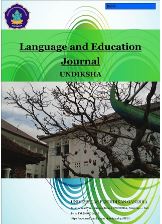SELF-DIRECTED LEARNING IN EFL DURING COVID-19 PANDEMIC: AN ANALYSIS OF TEACHER’S PERCEPTIONS AND STUDENTS’ LEARNING AUTONOMY IN SMAN 1 SEMARAPURA
DOI:
https://doi.org/10.23887/leju.v4i1.31960Keywords:
Self-directed learning, Teacher’s Perception, Teacher’s Activities, Self-directed Learning componentsAbstract
The purpose of this study is to analyze how the English teacher perception about Self-directed learning, to describe the activities assigned by the teacher in online learning, and to identify Self-directed Learning components that appears in the activities assigned by the teacher. The research design in this study used embedded mix-method research design which the data was dominant presented in a qualitative data and then supported by quantitative data. The subject of this study was one English teacher who teach in tenth grade students in SMA 1 Semarapura in Klungkung Regency. There were four research instruments used in this study, those are researcher, questionnaire, observation table, and identification table. There were three main result of this research. Firstly, the teacher has positive responses for the all of the aspects of perception in questionnaires which knowledgeable in terms of knowledge, very anticipated in terms of implementation and, influential in terms of impact. Secondly, the activities assigned is not optimal yet especially in the post activity and whilst activity. Thirdly, there are two Self-directed Learning components with four indicators appeared in the activities assigned by the teacher. The data showed that there was a mismatch between teacher perception and activities assigned by the teacher in online learning.
References
Adianingrum, E. K. (2017). Learner Autonomy in Language Learning : English Education Students ’ Attitudes. Conference on Language and Language Teaching, 1999, 473–478.
Alonazi, S. M. (2017). The Role of Teachers in Promoting Learner Autonomy in Secondary Schools in Saudi Arabia. English Language Teaching, 10(7), 183. https://doi.org/10.5539/elt.v10n7p183
Andariyani, N., & Nurhajati, D. (2016). the Implementation of Teaching English Based on Curriculum 2013 Applied By an English Teacher of Junior High School. English Education: Journal of English Teaching and Research, 1(2), 9. https://doi.org/10.29407/jetar.v1i2.480
Arizatul Humaira’, S., & Ajeng Hurriyah, I. (2018). Students’ Perspectives towards Self-Directed Learning out of Classroom. Advances in Social Science, Education and Humanities Research, 145(Iconelt 2017), 6–11. https://doi.org/10.2991/iconelt-17.2018.2
Begum, J. (2018). Learner autonomy in efl/esl classrooms in bangladesh: Teachers’ perceptions and practices. International Journal of Language Education, 2(2), 96–104. https://doi.org/10.26858/ijole.v2i2.6411
Bijami, M., Kashef, S. H., & Nejad, M. S. (2013). Peer Feedback in Learning English Writing: Advantages and Disadvantages. Journal of Studies in Education, 3(4), 91. https://doi.org/10.5296/jse.v3i4.4314
Boyadzhieva, E. (2016). Learner-centered Teaching and Learner Autonomy. Procedia - Social and Behavioral Sciences, 232(April), 35–40. https://doi.org/10.1016/j.sbspro.2016.10.008
Caravello, M. J., Jiménez, J. R., Kahl, L. J., Brachio, B., Ed, D., Morote, E., & Ed, D. (2015). Self-Directed Learning : College Students ’ Technology Preparedness Change in the Last 10 Years. Journal for Leadership and Instruction, 14(2), 18–25.
Creswell, J. W. (2014). Research design: Qualitative, quantitative, and mixed method approaches. Sage.
Curran, V., Gustafson, D. L., Simmons, K., Lannon, H., Wang, C., Garmsiri, M., Fleet, L., & Wetsch, L. (2019). Adult learners’ perceptions of self-directed learning and digital technology usage in continuing professional education: An update for the digital age. Journal of Adult and Continuing Education, 25(1), 74–93. https://doi.org/10.1177/1477971419827318
Gharti, L. (2019). Self-Directed Learning for Learner Autonomy: Teachers’ and Students’ Perceptions. Journal of NELTA Gandaki, 1, 62–73. https://doi.org/10.3126/jong.v1i0.24461
Gulchekhra, K. (2016). Benefits of Implementation of Pre- While and Post Reading Activities in Language Learning. International Journal of Science, 1(4), 45–46.
Moradi, H. (2018). Self-directed Learning in Language Teaching-learning Processes. Modern Journal of Language Teaching Methods (MJLTM), 8(2007), 59–64.
Muganga, L., & Ssenkusu, P. (2019). Teacher-Centered vs. Student-Centered. Cultural and Pedagogical Inquiry, 11(2), 16–40. https://doi.org/10.18733/cpi29481
Sipayung, H. D., Sani, R. A., & Bunawan, W. (2018). Collaborative Inquiry For 4C Skills. Advances in Social Science, Education and Humanities Research, 200(Aisteel), 440–445. https://doi.org/10.2991/aisteel-18.2018.95
Tan, L., & Ling, J. K. H. (2014). Self-Directed Learning : Learning in the 21st Century (Issue December). Ministry of Education.
Tri, T. M., Hong, B. Van, & Xuan, V. T. (2017). Self- directed learning in the context of internationalization in TVET in Vietnam. Tvet-Online.Asia, 9, 1–14.
Zulaihah, S., & Harida, R. (2017). Autonomous Learning Strategy of the Successful Nontraditional Students. ELTIN JOURNAL, Journal of English Language Teaching in Indonesia, 5(2), 71. https://doi.org/10.22460/eltin.v5i2.p71-84










